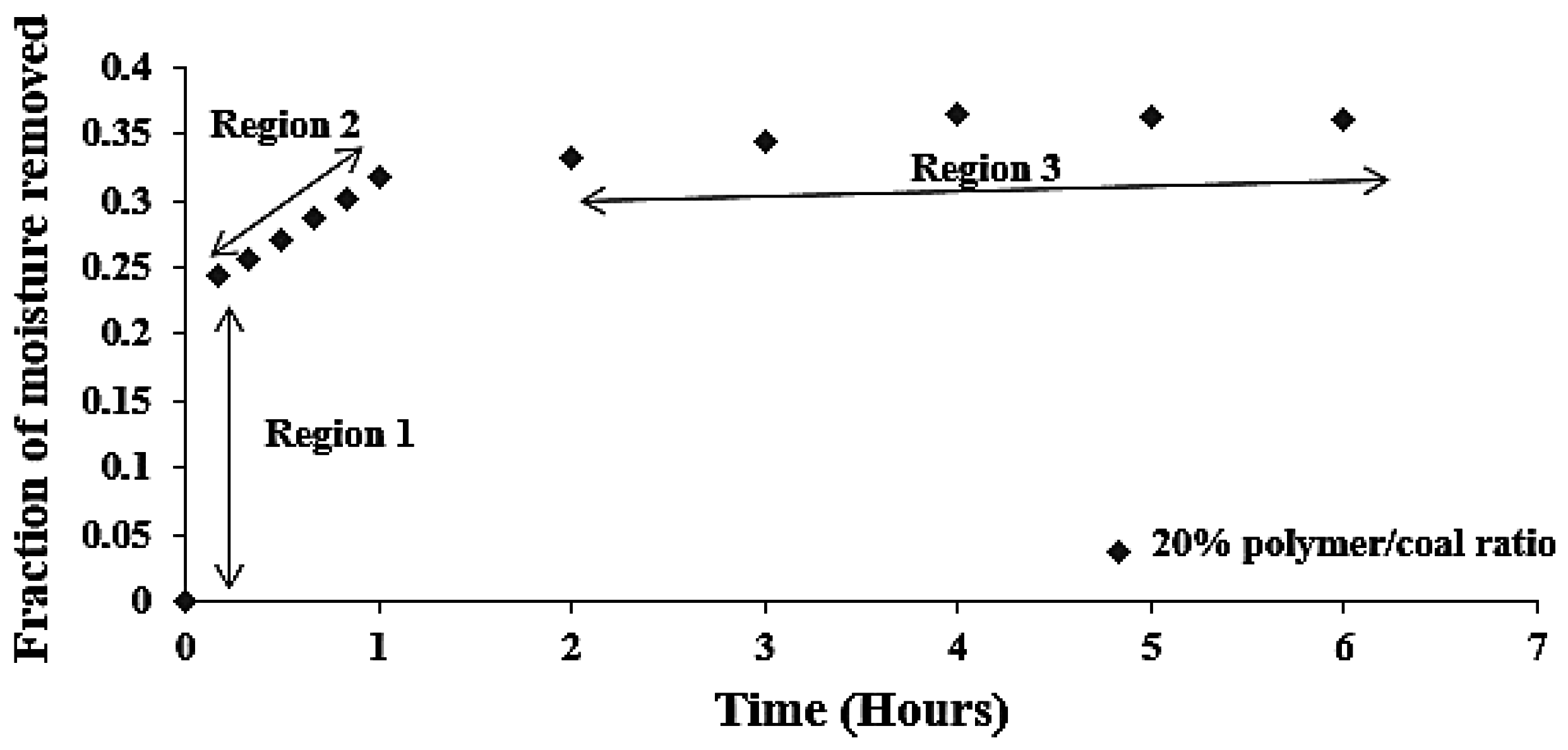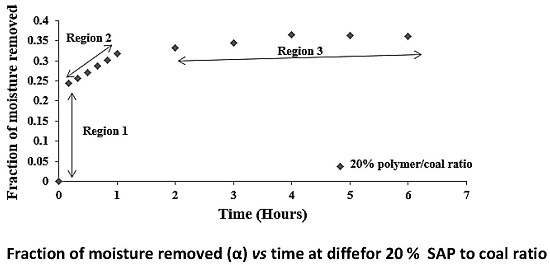Brown Coal Dewatering Using Poly (Acrylamide-Co-Potassium Acrylic) Based Super Absorbent Polymers
Abstract
:1. Introduction
1.1. Victorian Brown Coals


1.2. Brown Coal Drying
1.3. Super Absorbent Polymers (SAP)
- Swelling properties (attributed to presence of hydrophilic groups in the network).
- Cross linking density (generally higher molecular weight with lower cross linking densities exhibits higher absorption capacities).
- Structural integrity (high cross linking density is crucial to retain the structural integrity of the polymer loaded with moisture as the high cross-linking density offers high mechanical strength).
- The “availability” of target water i.e., how tightly it is bound to the drying substrate.

1.4. Standard Method of Moisture Determination
2. Methodology of the SAP Dewatering Process

3. Experimental
3.1. Materials
3.1.1. Brown Coal
| Coal Properties | Percentage (% Dry Basis) |
|---|---|
| Moisture | 59.3 * |
| Ash | 2.2 |
| Volatile matter | 50.5 |
| Carbon | 68.4 |
| Hydrogen | 5.1 |
| Sulphur | 0.3 |
3.1.2. Super Absorbent Polymers (SAP) Used in this Work

3.2. Experimental Methods
3.2.1. Fourier Transform Infrared (FTIR)
| Frequency (cm−1) | Functional Groups | Reference |
|---|---|---|
| 3350–3600 | Stretching vibration of OH groups (water, alcohol, phenol, carbohydrates, peroxides) as well as amides (3650 cm−1) | (Liu et al., 2006) [22] Vijayalakshmi and Ravindhran, 2012 [24] |
| 2750–3000 | CH3 and CH2 (aliphatic) | (Chandarlal et al., 2014) [23] |
| 1700 | Carboxylic acid and ketone groups | (Chandarlal et al., 2014) [23] |
| 1649 | Adsorbed water | (Li et al., 2001) [24] |
| 1618–1622 | C=O, aromatic rings | (Chandarlal et al., 2014) [23] |
| 1440 | CH2, C=O bending mode of H-bonded O–H groups | (Chandarlal et al., 2014) [23] |
| 1000–1300 | Phenoxy structure, aliphatic ethers, alcohols | (Chandarlal et al., 2014) [23] |
| 1355 | Benzene or condensed benzene rings | (Chandarlal et al., 2014) [23] |
| 1180 | Sp-3 rich structure COOH and OH | (Chandarlal et al., 2014) [23] |
| 997–1130 | Stretching vibration of C–O of mono, oligo and carbo-hydrates | (Vijayalakshmi and Ravindhran, 2012) [25] |
| <1000 | C–H bending vibration from isoprenoids | (Vijayalakshmi and Ravindhran, 2012) [25] |
| 870–750 | Weak absorption due to C–H bending vibrations of olefinic and aromatic structures | (Verheyen and Perry 1991) [4] |

3.2.2. Dewatering Tests

4. Results and Discussion
| Phenolic OH (Dry Basis) | COOH (Dry Basis) | COO (Dry Basis) | Phenolic Oxygen (Dry Basis) | Carboxylic Oxygen (Dry Basis) | Acidic Oxygen | Total Oxygen (Dmif) | Acidic Oxygen |
|---|---|---|---|---|---|---|---|
| meq/g | Percentage (%) | ||||||
| 3.04 | 2.39 | 0.10 | 4.86 | 7.97 | 13.0 | 24.7 | 53 |
4.1. Moisture Results

| Polymer/Coal Ratio (%) | |||||||
| - | 0 | 5 | 10 | 15 | 20 | 25 | 30 |
| Hours | Final Moisture Content (%) | ||||||
| 0 | 59.3 | 59.3 | 59.3 | 59.3 | 59.3 | 59.3 | 59.3 |
| 1 | 58.7 | 48.8 | 44.8 | 43.6 | 41.3 | 44 | 42.2 |
| 2 | 58.7 | 48.8 | 44.6 | 43.4 | 40.4 | 40.8 | 41.5 |
| 3 | 58.4 | 48.2 | 43.7 | 43.1 | 40.2 | 40.4 | 41.7 |
| 4 | 58 | 48.5 | 44.2 | 42.3 | 38.6 | 39.7 | 40.3 |
| 5 | 58.2 | 48.6 | 44.2 | 42.2 | 39.7 | 39.3 | 40.3 |
| 6 | 58.2 | 47.6 | 44.3 | 42.2 | 39.2 | 39.3 | 40.2 |
4.2. Dewatering Kinetics

- Region 1: Dissociation and breaking of chemically adsorbed and surface moisture (chemical process).
- Region 2: Desorption of water (bound and free water)/and breaking of liquid bridges in coal (chemical and physical process).
- Region 3: Diffusion/mass transfer process (physical process).
4.3. Surface Chemical and Diffusion Control Model

4.4. Fourier Transform Infrared (FTIR ATR)




5. Conclusion
Acknowledgments
Author Contributions
Conflicts of Interest
References and Notes
- Allardice, D.J.; Newell, B.S. Industrial imlication of the properties of brown coal. In The Science of Victorian Brown Coal: Structure Properties and Consequences for Utilization; Durie, R.A., Ed.; Butterworh-Heinmann Ltd.: Oxford, UK, 1991. [Google Scholar]
- Mackay, A.M.; George, G.H. Petrology. In The Science of Victorian Brown Coal: Structure, Properties and Consequences for Utilization; Durie, R.A., Ed.; Buterworth-Heinemann Ltd.: Oxford, UK, 1991. [Google Scholar]
- Australia’s Coal Industry. Available online: http://www.minerals.org.au/resources/coal/coal_mines_by_state (accessed on 24 September 2015).
- Verheyen, T.V.; Perry, G.J. Chemical structure of Victorian brown coal. In The Science of Victorian Brown Coal: Structure Properties and Consequences for Utilization; Durie, R.A., Ed.; Butterworth-Heinmann Ltd.: Oxford, UK, 1991. [Google Scholar]
- Iyengar, M.S.; Sibal, D.H.; Lahiri, A. Role of hydrogen bonds in the briquetting of lignite. Fuel 1957, 36, 76–84. [Google Scholar]
- Allardice, D.J.; Evans, D.G. The brown coal/water system: Part 2. Water sorption isotherms on bed moisture Yallourn brown coal. Fuel 1971, 50, 236–253. [Google Scholar] [CrossRef]
- Schafer, H.N.S. Factors effecting the equilibrum moisture content of low rank coals. Fuel 1972, 51, 4–9. [Google Scholar] [CrossRef]
- Kumagai, H.; Chiba, T.; Nakamura, K. Change in physical and chemical characteristics of brown coal along with a progress of moisture release. In Abstracts of Papers of the American Chemical Society; American Chemical Society: Washington, DC, USA, 1999; Volume 218. [Google Scholar]
- Fleissner, H. The Drying of Fuels and the Australian Coal Industry. Sonderdruck Spartwirtschaft, 1927; Nos.10 and 11. [Google Scholar]
- Higgins, R.S.; Allardice, D.J. Development of Brown Coal Dewatering; Reserach and Deveopment Report; State Electricity Commission of Victoria (SECV): Victoria, Australia, 1973. [Google Scholar]
- Murray, R.G. Stable high enery solid fuel from lignite. Coal Process Tech. 1979, 5, 211–214. [Google Scholar]
- Hulston, J.; Favas, G.; Chaffee, A.L. Physico-chemical properties of Loy Yang lignite dewatered by mechanical thermal expression. Fuel 2005, 84, 1940–1948. [Google Scholar] [CrossRef]
- Reuter, F.; Molek, H.; Kockert, W.; Lange, W. Laboratory desalination of brown coal by elecrto-osmosis. Neue Bergbautechnik 1981, 11, 186–187. [Google Scholar]
- Dzinomwa, G.P.T.; Wood, C.J.; Hill, D.J.T. Fine coal dewatering using pH-sensitive and temeprature sensitive super absorbent polymers. Polym. Adv. Technol. 1997, 8, 767–772. [Google Scholar] [CrossRef]
- Masuda, K.; Iwata, H.; Masuda, K.; Iwata, H. Dewatering of particulate materials utilizing highly water-absorptive polymer. Powder Technol. 1990, 63, 113–119. [Google Scholar] [CrossRef]
- Moody, G.M. Role of polyacrylamides and related products in treatment of mineral processing effluent. Trans. Inst. Min. Metall. 1990, 99, C136. [Google Scholar]
- SadeghiI, M.; Hosseinzadeh, H. Synthesis and properties of collagen-g-poly(sodium acrylate-co-2-hydroxyethylacrylate) superabsorbent hydrogels. Braz. J. Chem. Eng. 2013, 30, 379–389. [Google Scholar] [CrossRef]
- Jiang, S.Q.; Sun, X.W.; Xie, Z.X.; Qin, L. Study on synthesis and property of anti-salt super absorbent resin. Adv. Mater. Res. 2013, 873, 683–688. [Google Scholar] [CrossRef]
- Laftha, W.A.; Hashim, S.; Ibrahim, A.N. Polymers hydrogel: A review. Polym. Plast. Technol. Eng. 2011, 50, 1475–1486. [Google Scholar] [CrossRef]
- Gloe, C.S.; Holdgate, G.R. Geology and Resources. In The Science of Victorian Brown Coal: Structure, Properties and Consequences for Utilization; Durie, R.A., Ed.; Butterworh-Heinmann Ltd.: Oxford, UK, 1991. [Google Scholar]
- Painter, P.C.; Starsinic, M.; Coleman, M.M. Fourier Transform Infrared Spectroscopy Applications to Chemical Systems; Ferraro, J.R., Basile, J.L., Eds.; Academic Press: Waltham, MA, USA, 1985. [Google Scholar]
- Liu, H.; Sun, S.Q.; Lv, G.H.; Chan, K.K. Study on Angelica and its different extracts by Fourier transform infrared spectroscopy and two-dimensional correlation IR spectroscopy. Spectrochim. Acta Part A 2006, 64, 321–326. [Google Scholar] [CrossRef] [PubMed]
- Chandarlal, N.; Mahapatra, D.; Shome, D.; Dasgupta, P. Behaviour of low rank high mositure coal in small stockpile under controlled ambient condition—A approach. Am. Int. J. Res. Form. Appl. Nat. Sci. 2014, 6, 98–108. [Google Scholar]
- Li, H.; Khor, K.A.; Cheang, P. HVOF Sprayed Hydroxyapatite Coatings: Powders’ Smelting State and Mechanical Properties. In Thermal Spray 2001: New Surface for a New Millenium; Berndt, C.C., Khor, K.A., Lugscheider, E.F., Eds.; ASM International: Geouga County, OH, USA, 2001; pp. 99–104. [Google Scholar]
- Vijayalakshmi, R.; Ravindhran, R. Comparitive fingureprint and extraction yield of diospyrus ferrea(wild.) Bakh. root with phenol compounds (gallic acid), as determined by UV-Vis and FT-IR spectroscopy. Asian Pac. J. Trop. Biomed. 2012, 2, 1367–1371. [Google Scholar] [CrossRef]
- Hayashi, J.; Li, C.-Z. Structure and properties. In Advances in the Science of Victorian Brown Coal, 1st ed.; Li, C.Z., Ed.; Elsevier Ltd.: Amsterdam, The Netherlands, 2004; pp. 11–78. [Google Scholar]
- Schafer, H.N.S. Functional groups and ion exchange prooperties. In The Science of Victorian Brown Coal; Durie, R.A., Ed.; Butterworh-Heinmann Ltd.: Oxford, UK, 1991. [Google Scholar]
- Szekely, J.; Evans, J.W.; Sohn, H.Y. Gas-Solid Reaction; Academic Press: New York, NY, USA, 1976. [Google Scholar]
- Meekum, U. Study of the molecular srain of polymerizable cyclic oligocarbonates using the spectroscopic techique. Suranaree J. Sci. Technol. 2005, 12, 107–113. [Google Scholar]
© 2015 by the authors; licensee MDPI, Basel, Switzerland. This article is an open access article distributed under the terms and conditions of the Creative Commons by Attribution (CC-BY) license (http://creativecommons.org/licenses/by/4.0/).
Share and Cite
Devasahayam, S.; Ameen, M.A.; Verheyen, T.V.; Bandyopadhyay, S. Brown Coal Dewatering Using Poly (Acrylamide-Co-Potassium Acrylic) Based Super Absorbent Polymers. Minerals 2015, 5, 623-636. https://doi.org/10.3390/min5040512
Devasahayam S, Ameen MA, Verheyen TV, Bandyopadhyay S. Brown Coal Dewatering Using Poly (Acrylamide-Co-Potassium Acrylic) Based Super Absorbent Polymers. Minerals. 2015; 5(4):623-636. https://doi.org/10.3390/min5040512
Chicago/Turabian StyleDevasahayam, Sheila, M. Anas Ameen, T. Vincent Verheyen, and Sri Bandyopadhyay. 2015. "Brown Coal Dewatering Using Poly (Acrylamide-Co-Potassium Acrylic) Based Super Absorbent Polymers" Minerals 5, no. 4: 623-636. https://doi.org/10.3390/min5040512
APA StyleDevasahayam, S., Ameen, M. A., Verheyen, T. V., & Bandyopadhyay, S. (2015). Brown Coal Dewatering Using Poly (Acrylamide-Co-Potassium Acrylic) Based Super Absorbent Polymers. Minerals, 5(4), 623-636. https://doi.org/10.3390/min5040512






